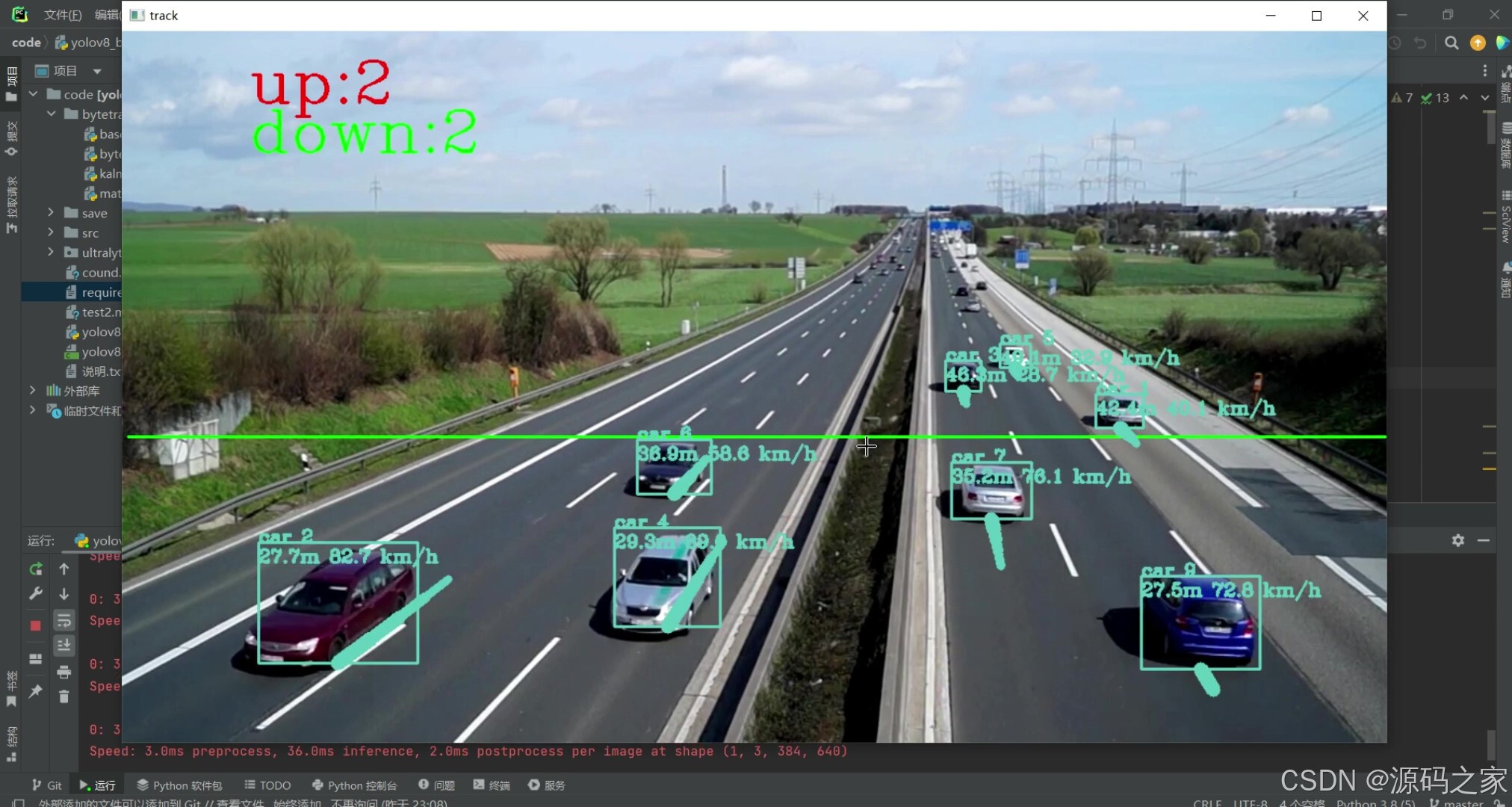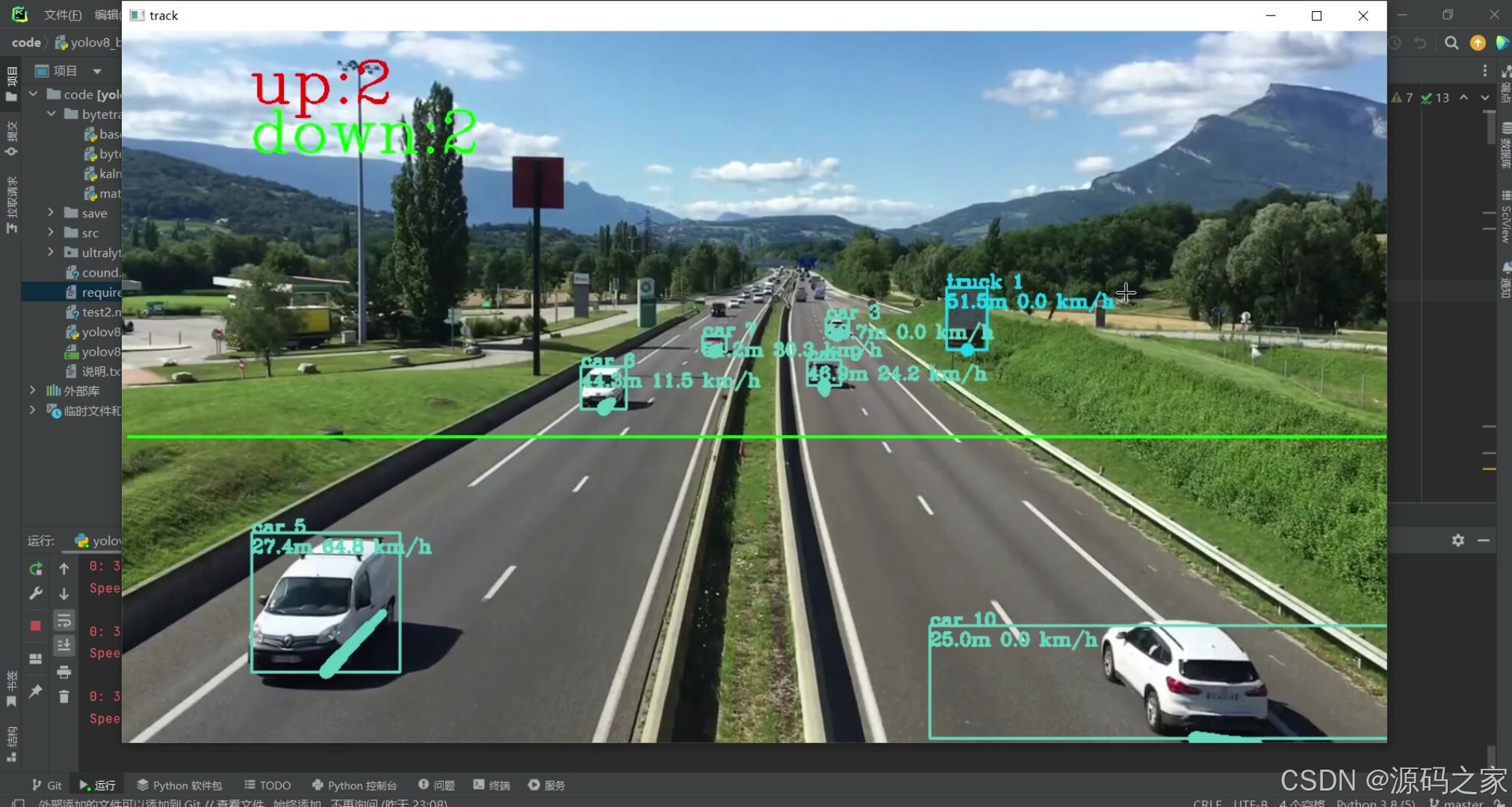博主介绍:✌全网粉丝50W+,前互联网大厂软件研发、集结硕博英豪成立软件开发工作室,专注于计算机相关专业项目实战6年之久,累计开发项目作品上万套。凭借丰富的经验与专业实力,已帮助成千上万的学生顺利毕业,选择我们,就是选择放心、选择安心毕业✌
> 🍅想要获取完整文章或者源码,或者代做,拉到文章底部即可与我联系了。🍅
2、大数据、计算机专业选题(Python/Java/大数据/深度学习/机器学习)(建议收藏)✅
1、项目介绍
- 技术栈:Python语言、YOLOv8、ByteTrack算法、YOLOv8测速+测距+车辆计数、目标计数+目标测速
- 这个项目的研究背景:当前交通监控、公共区域安全管理等场景中,传统人工监控方式存在效率低、实时性差的问题,难以精准完成目标(如车辆、行人)的检测、跟踪及测速测距;同时,传统系统对遮挡目标的识别率低,易出现漏检和轨迹碎片化,导致流量统计、速度监测数据不准确,无法为交通调度、安全管控提供可靠数据支撑,这些痛点制约了监控场景的智能化升级。
- 这个项目的研究意义:技术层面,通过YOLOv8提升目标检测精度,结合ByteTrack算法解决遮挡目标漏检问题,实现高效多目标跟踪;功能层面,集成测速、测距、车辆计数功能,满足实时监控数据需求;行业层面,为交通监控、智慧园区等领域提供智能化分析工具,助力提升管理效率与决策准确性,推动监控场景从“人工值守”向“智能分析”转型,具备实际应用价值。
2、项目界面
(1)测速测距车辆计数界面1

(2)测速测距车辆计数界面2

(3)测速测距车辆计数界面3

3、项目说明
本项目是基于Python语言开发的目标检测与跟踪分析系统,融合YOLOv8目标检测算法与ByteTrack多目标跟踪算法,核心实现车辆等目标的测速、测距及计数功能,旨在解决传统监控场景中检测精度低、数据统计不准确的问题。项目首先通过argparse模块解析命令行参数,配置检测模型权重路径、输入输出视频路径、置信度阈值、相机参数(高度、角度、内参)等,为后续功能提供基础配置;接着将相机内参转换为3×3numpy数组,用于后续深度计算。在目标检测环节,加载ultralytics的YOLO模型,对视频每一帧图像进行检测,获取目标检测框、置信度及类别信息,并将结果传递至跟踪模块。跟踪模块初始化BYTETracker对象,基于卡尔曼滤波预测目标下一帧位置,以IoU为相似度指标,通过匈牙利算法完成检测框与轨迹的匹配,同时关联低分检测框以恢复遮挡目标,避免漏检与轨迹碎片化,为每个目标分配唯一跟踪ID。系统还实现轨迹绘制与流量统计功能:为每个目标维护轨迹队列,记录运动轨迹并在图像上绘制;通过设置虚拟计数线,判断目标是否穿过线条,统计进入与离开的目标数量。在距离与速度计算上,结合相机模型、目标图像位置及相机参数计算目标深度,利用连续两帧的深度变化与时间间隔,将速度换算为公里/小时单位。图像可视化环节,在帧图像上叠加检测框、类别、跟踪ID、速度及计数结果,若开启可视化参数则实时展示结果。视频处理流程中,通过cv2.VideoCapture读取输入视频,逐帧调用检测处理方法,最后将处理后的帧写入输出视频文件。整体而言,系统整合检测、跟踪、计算、可视化全流程,适用于交通监控、人群分析等场景,为相关领域提供精准的实时数据支撑,具备较强的智能化与实用性。
4、核心代码
import cv2
import torch
from ultralytics import YOLO
import os
import argparse
from bytetrack_tracker.byte_tracker import BYTETracker
from collections import deque
import numpy as np
import math
parser = argparse.ArgumentParser()
# 检测参数
parser.add_argument('--weights', default=r"yolov8m.pt", type=str, help='weights path')
# 设置检测的视频路径
parser.add_argument('--source', default=r"cound.mp4", type=str, help='img or video(.mp4)path')
# parser.add_argument('--source', default=r"test2.mp4", type=str, help='img or video(.mp4)path')
parser.add_argument('--save', default=r"./save", type=str, help='save img or video path')
parser.add_argument('--vis', default=True, action='store_true', help='visualize image')
parser.add_argument('--conf_thre', type=float, default=0.5, help='conf_thre')
parser.add_argument('--iou_thre', type=float, default=0.5, help='iou_thre')
# 跟踪参数
parser.add_argument('--track_thresh', type=float, default=0.5, help='track_thresh')
parser.add_argument('--track_buffer', type=int, default=70, help='track_buffer')
parser.add_argument('--match_thresh', type=float, default=0.8, help='match_thresh')
# 添加高度(H)、角度(alpha)和相机内参(calib)参数
parser.add_argument('--H', type=float, default=6.5, help='Height of the camera from the ground')
parser.add_argument('--alpha', type=int, default=8, help='Angle of the camera view')
parser.add_argument('--calib', type=str, default='2900,0.0,640; 0.0,2900,360; 0.0,0.0,1.0',
help='Camera intrinsic parameters')
# 解析参数
opt = parser.parse_args()
# 将字符串形式的 calib 转换为 numpy 数组
calib_values = [float(x) for x in opt.calib.replace(';', ',').split(',')]
opt.calib = np.array(calib_values).reshape(3, 3)
device = torch.device('cuda:0' if torch.cuda.is_available() else 'cpu')
class Detector(object):
def __init__(self, weight_path, conf_threshold=0.5, iou_threshold=0.5):
self.device = device
self.model = YOLO(weight_path).to(self.device)
self.conf_threshold = conf_threshold
self.iou_threshold = iou_threshold
self.tracker = BYTETracker(track_thresh=opt.track_thresh, track_buffer=opt.track_buffer,
match_thresh=opt.match_thresh)
self.pointlist = [(6, 410), (1278, 410)]
self.trajectories = {}
self.max_trajectory_length = 5
self.id_in = 0
self.id_in_list = []
self.id_out = 0
self.id_out_list = []
@staticmethod
def get_color(idx):
idx = idx * 3
color = ((37 * idx) % 255, (17 * idx) % 255, (29 * idx) % 255)
return color
def draw_measure_line(self, H, calib, u, v, alpha):
alpha = alpha # 角度a
# 相机焦距
fy = calib[1][1]
# 相机光心
u0 = calib[0][2]
v0 = calib[1][2]
pi = math.pi
Q_pie = [u - u0, v - v0]
gamma_pie = math.atan(Q_pie[1] / fy) * 180 / np.pi
beta_pie = alpha + gamma_pie
if beta_pie == 0:
beta_pie = 1e-2
z_in_cam = (H / math.sin(beta_pie / 180 * pi)) * math.cos(gamma_pie * pi / 180)
return z_in_cam
def detect_image(self, img_bgr):
results = self.model(img_bgr, conf=self.conf_threshold, iou=self.iou_threshold)
# Extracting the necessary details from the results
boxes = results[0].boxes.xyxy.cpu().numpy() # xyxy format
confidences = results[0].boxes.conf
class_preds = results[0].boxes.cls
confidences_expanded = confidences.unsqueeze(1)
class_preds_expanded = class_preds.unsqueeze(1)
boxes_tensor = torch.from_numpy(boxes).to(class_preds_expanded.device)
result = torch.cat((boxes_tensor, confidences_expanded, class_preds_expanded), dim=1)
online_targets = self.tracker.update(result.cpu(), [results[0].orig_shape[0], results[0].orig_shape[1]])
cv2.line(img_bgr, self.pointlist[0], self.pointlist[1], (0, 255, 0), 2)
for t in online_targets:
speed_km_per_h = 0
tlwh = t.tlwh
xmin, ymin, xmax, ymax = tlwh[0], tlwh[1], tlwh[0] + tlwh[2], tlwh[1] + tlwh[3]
tid = t.track_id
cls = t.cls.item()
class_pred = int(cls)
color = self.get_color(class_pred + 2)
bottom_center = (int(tlwh[0] + tlwh[2] / 2), int(tlwh[1] + tlwh[3]))
bbox_label = results[0].names[class_pred]
cv2.rectangle(img_bgr, (int(xmin), int(ymin)), (int(xmax), int(ymax)), color, 2)
zc_cam_other = self.draw_measure_line(opt.H, opt.calib, int(tlwh[0] + tlwh[2] / 2), int(tlwh[1] + tlwh[3]),
opt.alpha)
if tid not in self.trajectories:
self.trajectories[tid] = deque(maxlen=self.max_trajectory_length)
trajectory_point = {
'bottom_center': bottom_center,
'zc_cam_other': zc_cam_other
}
self.trajectories[tid].appendleft(trajectory_point)
# 截断轨迹长度
if len(self.trajectories[tid]) > self.max_trajectory_length:
self.trajectories[tid] = self.trajectories[tid][:self.max_trajectory_length]
for i in range(1, len(self.trajectories[tid])):
if self.trajectories[tid][i - 1] is None or self.trajectories[tid][i] is None:
continue
thickness = int(np.sqrt(64 / float(i + 1)) * 2.5)
cv2.line(img_bgr, self.trajectories[tid][i - 1]['bottom_center'],
self.trajectories[tid][i]['bottom_center'], color,
thickness)
# 通过阈值判断是竖线还是横线,若x2和x1之间的差值小于20 判断为竖线 否则为横线
"""
例如:如下垂线上下两点的x保持不变,y存在变化 所以垂线的x2-x1=0
*
*
*
*
如下横线左右两点的y保持不变,x存在变化 所以横线的y2-y1=0
***********
"""
if abs(self.pointlist[1][0] - self.pointlist[0][0]) < 20:
# 通过判断同一个目标上下两帧是否过线 来进行计数
# self.trajectories[tid][i - 1][0]代表上一帧 self.trajectories[tid][i][0]代表当前帧
if ((self.trajectories[tid][i - 1]['bottom_center'][0] <= self.pointlist[0][0]) and
(self.trajectories[tid][i]['bottom_center'][0] > self.pointlist[0][0])) and \
((self.trajectories[tid][i]['bottom_center'][1] > self.pointlist[1][
1]) and # 设置目标的撞线范围 不得超线
(self.trajectories[tid][i]['bottom_center'][1] < self.pointlist[0][1])):
# 如果目标ID已经计数过,则忽略
if tid in self.id_in_list:
continue
# 否则,增加进入计数,并将ID添加到已计数列表中
else:
self.id_in += 1
self.id_in_list.append(tid)
if ((self.trajectories[tid][i - 1]['bottom_center'][0] >= self.pointlist[0][0]) and
(self.trajectories[tid][i]['bottom_center'][0] < self.pointlist[0][0])) and \
((self.trajectories[tid][i]['bottom_center'][1] > self.pointlist[1][1]) and
(self.trajectories[tid][i]['bottom_center'][1] < self.pointlist[0][1])):
if tid in self.id_out_list:
continue
else:
self.id_out += 1
self.id_out_list.append(tid)
else:
if ((self.trajectories[tid][i - 1]['bottom_center'][1] >= self.pointlist[0][1]) and
(self.trajectories[tid][i]['bottom_center'][1] < self.pointlist[0][1])) and \
((self.trajectories[tid][i]['bottom_center'][0] > self.pointlist[0][0]) and
(self.trajectories[tid][i]['bottom_center'][0] < self.pointlist[1][0])):
if tid in self.id_in_list:
continue
else:
self.id_in += 1
self.id_in_list.append(tid)
if ((self.trajectories[tid][i - 1]['bottom_center'][1] <= self.pointlist[0][1]) and
(self.trajectories[tid][i]['bottom_center'][1] > self.pointlist[0][1])) and \
((self.trajectories[tid][i]['bottom_center'][0] > self.pointlist[0][0]) and
(self.trajectories[tid][i]['bottom_center'][0] < self.pointlist[1][0])):
if tid in self.id_out_list:
continue
else:
self.id_out += 1
self.id_out_list.append(tid)
time_interval = 1 / fps
speed_m_per_s = abs(self.trajectories[tid][i]['zc_cam_other'] - self.trajectories[tid][i - 1][
'zc_cam_other']) / time_interval
speed_km_per_h = speed_m_per_s * 3.6 # 转换为公里/小时
# 显示类名和跟踪ID
cv2.putText(img_bgr, f"{bbox_label} {int(tid)}",
(int(tlwh[0]), int(tlwh[1])), cv2.FONT_HERSHEY_COMPLEX, 0.6, color, 2)
# 显示速度,纵坐标比类名和跟踪ID的位置稍低一些
cv2.putText(img_bgr, f"{zc_cam_other:.1f}m {speed_km_per_h:.1f} km/h",
(int(tlwh[0]), int(tlwh[1]) + 20), cv2.FONT_HERSHEY_COMPLEX, 0.6, color, 2)
cv2.putText(img_bgr, str(f"down:{self.id_in}"),
(int(img_bgr.shape[1] * 0.1), int(img_bgr.shape[0] * 0.17)), cv2.FONT_HERSHEY_COMPLEX,
2,
(0, 255, 0), 2)
cv2.putText(img_bgr, str(f"up:{self.id_out}"),
(int(img_bgr.shape[1] * 0.1), int(img_bgr.shape[0] * 0.1)), cv2.FONT_HERSHEY_COMPLEX,
2,
(0, 0, 255), 2)
return img_bgr
# Example usage
if __name__ == '__main__':
model = Detector(weight_path=opt.weights, conf_threshold=opt.conf_thre, iou_threshold=opt.iou_thre)
capture = cv2.VideoCapture(opt.source)
fps = capture.get(cv2.CAP_PROP_FPS)
size = (int(capture.get(cv2.CAP_PROP_FRAME_WIDTH)),
int(capture.get(cv2.CAP_PROP_FRAME_HEIGHT)))
fourcc = cv2.VideoWriter_fourcc('m', 'p', '4', 'v')
outVideo = cv2.VideoWriter(os.path.join(opt.save, os.path.basename(opt.source).split('.')[-2] + "_out.mp4"), fourcc,
fps, size)
while True:
ret, frame = capture.read()
if not ret:
break
img_vis = model.detect_image(frame)
outVideo.write(img_vis)
img_vis = cv2.resize(img_vis, None, fx=1, fy=1, interpolation=cv2.INTER_NEAREST)
cv2.imshow('track', img_vis)
cv2.waitKey(30)
capture.release()
outVideo.release()
🍅✌感兴趣的可以先收藏起来,点赞关注不迷路,想学习更多项目可以查看主页,大家在毕设选题,项目编程以及论文编写等相关问题都可以给我留言咨询,希望可以帮助同学们顺利毕业!🍅✌
5、源码获取方式
🍅由于篇幅限制,获取完整文章或源码、代做项目的,拉到文章底部即可看到个人联系方式。🍅
点赞、收藏、关注,不迷路,下方查看👇🏻获取联系方式👇🏻
























✅&spm=1001.2101.3001.5002&articleId=152281749&d=1&t=3&u=2e7e3e6f22af42f9ab300d761b5d74c9)
 592
592

 被折叠的 条评论
为什么被折叠?
被折叠的 条评论
为什么被折叠?








